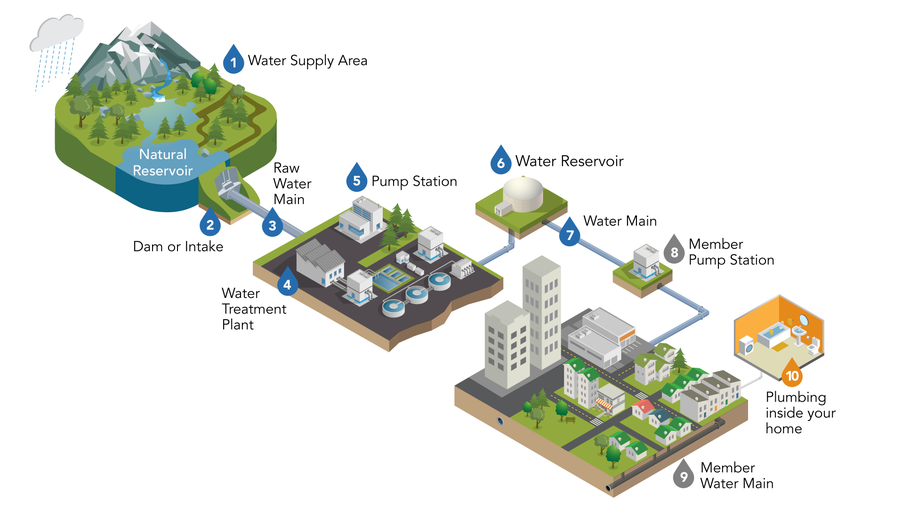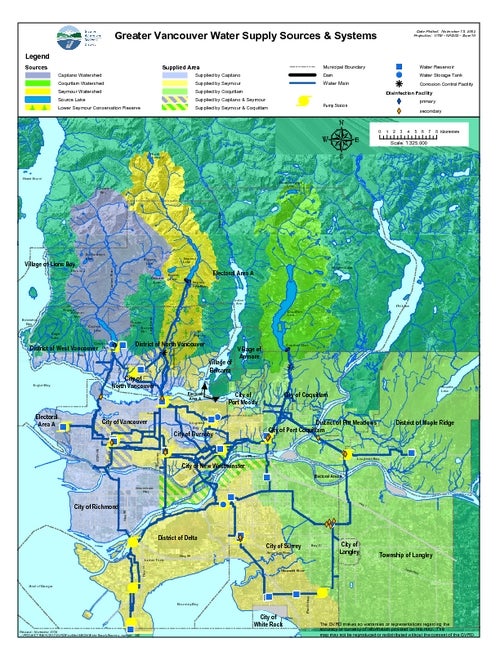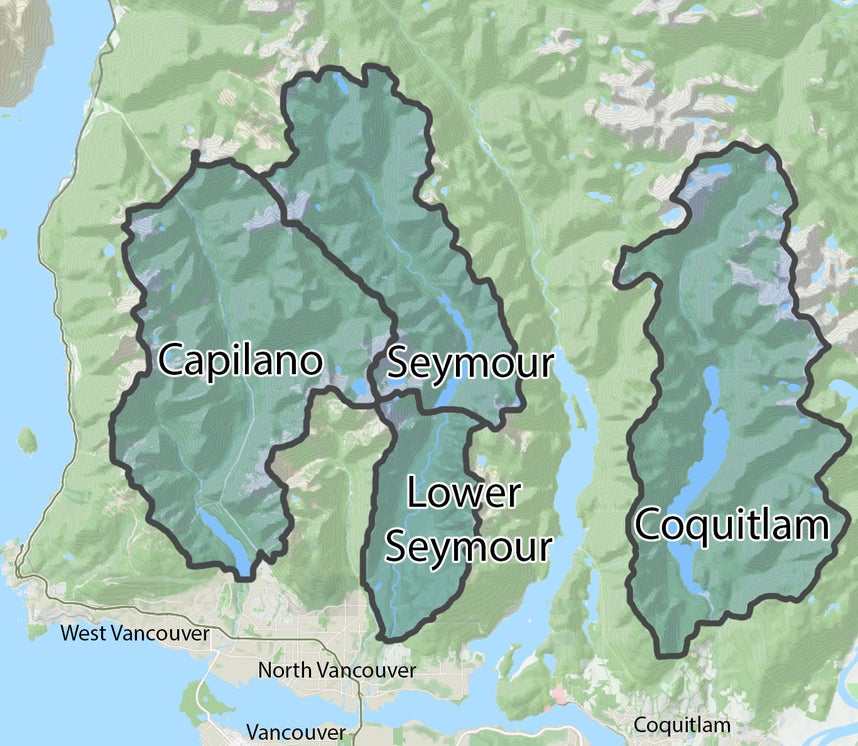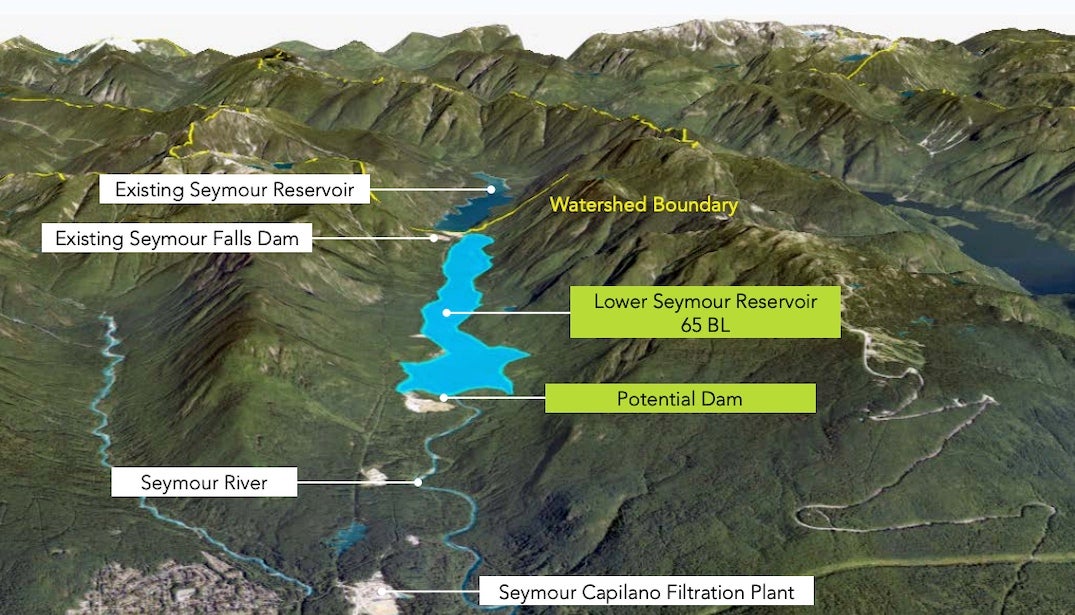
 The Township of Langley is home to approximately 117,258 residents. Of these, approximately 94,809 have water supplied by the Township, while the remaining use water from either private wells, or from community wells. There are 19 separate municipal water sources within the Township; 18 wells and the Greater Vancouver Water District (GVWD).
The Township of Langley is home to approximately 117,258 residents. Of these, approximately 94,809 have water supplied by the Township, while the remaining use water from either private wells, or from community wells. There are 19 separate municipal water sources within the Township; 18 wells and the Greater Vancouver Water District (GVWD).
The City of Langley receives its water supply from Metro Vancouver’s Greater Vancouver Water District originating at Coquitlam Lake located in the mountains to our north. This water is treated and transported through a maze of underground pipes crossing the Fraser River at two locations passing through the City of Port Coquitlam, Pitt Meadows, the Township of Langley and the City of Surrey eventually supplying the City of Langley.

The City of Langley’s reservoir, located at 200A Street and 47A Avenue, is the size of a football field and contains 22,700,000 litres of water. The size of the reservoir is designed to serve the City for extended periods if there should be a major watermain break in the supply network.The reservoir is equipped with an automatic shut off valve, which will close if a large earthquake takes place. This will retain the water that exists in the reservoir, which then will be available for domestic and firefighting use. It can serve a population of 55,000, retain extra storage and provide adequate firefighting requirements for several hours.
The City of Langley is divided into two pressure zones. These zones split in the area of 53 Avenue with the north half being supplied by gravity from the Clayton reservoir in Surrey at all times and the south being supplied directly from our reservoir. If there is an increase in demand or decrease in supply in the north half of the City (a watermain break or a fire), automatic control valves located along 53 Avenue will open allowing water from our reservoir to supply the north sector in the interim.To ensure adequate pressures and circulation within the system, there are three 100 horsepower pumps each capable of supplying 105 litres per second with an additional standby pump available should the need arise. We also have a large standby diesel operated generator capable of operating the entire pump station and reservoir during a power outage. These pumps operate in stages as required starting with one then two then the third. They insure circulation of all stored water within a 3 to 4 day time frame. To insure our water remains at the highest standard for domestic use, it is tested weekly at 4 locations and elevations in the reservoir and 12 remote testing stations throughout the City.

The Water Services utility provides clean, high-quality drinking water to 2.5 million Metro Vancouver residents in the Lower Mainland. Over one billion litres of water flows through our taps every day.Where does it come from? Our water comes from rainfall and snowmelt in the mountainous areas called watersheds, north of the cities. There are three watersheds, Capilano, Seymour and Coquitlam. The mountains receive about 3.5 meters of rain (more than the city), mostly from October through April. In addition to the rainfall there is, on average, a 4.5 metre snowpack in the higher elevations each year.The rain and melting snow flows downhill through small lakes and streams into large collection lakes called reservoirs, where it is stored year round.
Our water comes from rainfall and snowmelt in the mountainous areas called watersheds, north of the cities. There are three watersheds, Capilano, Seymour and Coquitlam. The mountains receive about 3.5 meters of rain (more than the city), mostly from October through April. In addition to the rainfall there is, on average, a 4.5 metre snowpack in the higher elevations each year.The rain and melting snow flows downhill through small lakes and streams into large collection lakes called reservoirs, where it is stored year round.
 Our water comes from rainfall and snowmelt in the mountainous areas called watersheds, north of the cities. There are three watersheds, Capilano, Seymour and Coquitlam. The mountains receive about 3.5 meters of rain (more than the city), mostly from October through April. In addition to the rainfall there is, on average, a 4.5 metre snowpack in the higher elevations each year.The rain and melting snow flows downhill through small lakes and streams into large collection lakes called reservoirs, where it is stored year round.
Our water comes from rainfall and snowmelt in the mountainous areas called watersheds, north of the cities. There are three watersheds, Capilano, Seymour and Coquitlam. The mountains receive about 3.5 meters of rain (more than the city), mostly from October through April. In addition to the rainfall there is, on average, a 4.5 metre snowpack in the higher elevations each year.The rain and melting snow flows downhill through small lakes and streams into large collection lakes called reservoirs, where it is stored year round.Metro Vancouver captures, stores and treats your drinking water, then distributes it wholesale to our local government members using a network of dams, treatment facilities, water mains, pump stations, and storage reservoirs. The drinking water flows seamlessly into local governments’ distribution systems which deliver it to properties for businesses and residents.Future water supply
 .
. 
These sources have provided water for a growing region for many decades. Likely sources for additional water supply include increasing the volume of water allocated to drinking water from the Coquitlam Reservoir (where historically the majority is allocated to hydroelectricity generated by BC Hydro), and, in the longer term, potentially increasing the storage volume of the Seymour Reservoir.Metro Vancouver also evaluates additional options to access, store, treat and distribute water from fresh water sources such as Pitt or Harrison Lakes or the Fraser River, although these sources do not provide access to gravity-fed water distribution and would require additional treatment systems.

Expanding our water supply comes with both financial and environmental considerations. Some examples are dam safety, impacts to fish and wildlife, infrastructure costs, alignment with the existing distribution system and consideration of future effects of climate change.Like all natural resources, fresh drinking water is valuable. Thoughtful debate and discussion are an important part of understanding the costs and benefits of expanding our water supply.Metro Vancouver manages three watersheds, each with a water collecting reservoir, to provide 2.5 million residents with a clean, reliable and affordable supply of drinking water.
The watersheds are closed to the public for protection from pollution, erosion, fire and other hazards, with the exception of registered tours.Outside of the protected watershed boundaries, there are hundreds of kilometres of trails to access the North Shore forests. Most users of these trails are not even aware the drinking water reservoirs are close by.
Watershed – a mountainous, basin-shaped area descending into valleys with common streams and rivers all channeling water into the same place, such as a reservoir.
Reservoir – the water that is collected from the watershed and stored for community water supply. There are natural reservoirs with granite or soil bases, and man-made reservoirs which are often concrete. Capilano, Seymour and Coquitlam are all natural reservoirs.
Capilano Reservoir:
 North Vancouver’s Capilano Reservoir supplies a third of the region’s drinking water. The reservoir is contained by the Cleveland Dam (1954), also operated by Metro Vancouver. This reservoir sits in the steepest of the three watersheds that supply our drinking water.
North Vancouver’s Capilano Reservoir supplies a third of the region’s drinking water. The reservoir is contained by the Cleveland Dam (1954), also operated by Metro Vancouver. This reservoir sits in the steepest of the three watersheds that supply our drinking water.
 North Vancouver’s Capilano Reservoir supplies a third of the region’s drinking water. The reservoir is contained by the Cleveland Dam (1954), also operated by Metro Vancouver. This reservoir sits in the steepest of the three watersheds that supply our drinking water.
North Vancouver’s Capilano Reservoir supplies a third of the region’s drinking water. The reservoir is contained by the Cleveland Dam (1954), also operated by Metro Vancouver. This reservoir sits in the steepest of the three watersheds that supply our drinking water.Visitors can see the reservoir from Cleveland Dam at the north end of Capilano River Regional Park. You can also visit the Capilano River Hatchery, operated below Cleveland Dam since 1971.Seymour ReservoirLocated in the North Shore Mountains the Seymour Reservoir supplies a third of the region’s drinking water. Although the reservoir is closed to public access, the forests south of the reservoir, called the Lower Seymour Conservation Reserve (LSCR) are open to the public, offering many outdoor experiences, and the LSCR trails connect to many other popular trails on the North Shore.
The Seymour Dam (no public access) was reconstructed to modern standards including earthquake safety in 2007. Recently Metro Vancouver built a new drinking water filtration plant in the LSCR, visible from the main parking lot.Coquitlam ReservoirThe Coquitlam Reservoir supplies a third of the region’s drinking water. This supply proportion can increase to approximately half of the region’s supply during the summer peak demand season.The watershed sits just north of the city of Coquitlam, and has been a municipal drinking water source since the late 1890’s, (at that time, for the City of New Westminster).
BC Hydro owns and operates the Coquitlam Dam (major seismic upgrade 2008) and has an agreement with the Province for electricity. Metro Vancouver has an agreement with BC Hydro for drinking water.Recently Metro Vancouver through a joint initiative with the Kwikwetlem First Nation, Department of Fisheries and Oceans, BC Hydro, and stewardship groups has been exploring the potential to return a natural salmon to the watershed through the Coquitlam River.
Metro Vancouver treats your drinking water in two stages. First it is treated at the source (where it comes from). It is given additional (secondary) treatment where required as it travels throughout our region. This ensures that your drinking water is safe and clean when it reaches your home or businesses, even if you live far away from the original source.
Treatment at the SourceOur drinking water is treated right as it leaves the source reservoir to ensure it meets regulatory standards. Each drinking water treatment plant is designed specifically to treat the water coming from its corresponding reservoir. Read more about the facilities at the Seymour and Coquitlam Reservoirs here.Filtration at the Seymour-Capilano Filtration Plant (SCFP)Filtration improves drinking water by removing particulates, organic matter and micro-organisms. An added benefit of filtration is that less chlorine is required to maintain water quality in the distribution system. This facility also uses UV disinfection.
Disinfection with Ozone, UV and Chlorine at the Coquitlam Water Treatment Plant (CWTP)There are natural particles and microorganisms in any water source. Even at low levels we manage for these risks using a combination of ozone and ultra violet (UV) light and chlorine to inactivate any micro-organisms present in the source water.pH AdjustmentOur water, by nature’s design, has a low pH, alkalinity and mineral content. That means it is very soft water. To adjust the pH level we add lime (calcium hydroxide) or sodium carbonate.
These additives in no way impact the flavour or safety of our drinking water.The primary treatment process at the Seymour-Capilano Filtration Plant (SCFP) is filtration, and then UV and chlorine (this facility treats water from both the Capilano and Seymour Reservoirs).The primary treatment process at the Coquitlam Water Treatment Plant is UV, and then ozone and chlorine.
Treatment through the SystemAs water flows through the distribution system, the chlorine added during the primary treatment stage gradually breaks down, creating the potential for bacteria. If required, chlorine is added as a secondary disinfectant to preserve water quality as water travels to homes, businesses, and industries. Chlorine lasts long enough to treat the water, making it ideal for this purpose. Ozone and UV light are not suitable because they are either stationary (UV) or dissipate very quickly (ozone).
Why is chlorine chosen for secondary disinfection? Because it is extremely effective and stays in the water until it reaches its destination. Ozone breaks down too quickly, and UV treatment doesn’t last long enough. Secondary treatment ensures water continues to meet Health Canada’s standards as it travels through water mains across the region.The Drinking Water Management Plan published in 2011 explains the direction and priorities for drinking water in this region. Find out more about how your drinking water is treated, and current priorities, on page ten.
Common Queries about your Drinking WaterChlorine and odoursSome homes are closer to the rechlorination stations, and the odour can be stronger as water comes direct from the tap. Some residents are more sensitive to the odour from the chlorine added in the water treatment process. Chlorine is a gas, and it leaves the water quickly when exposed to air. Try this yourself – put a jug of tap water in the fridge to keep cold. You should notice that any chlorine odour is gone very quickly.Our water is softOur water source is rain (and snow) and it doesn’t spend a lot of time stored in rocks so has a low mineral content.
Cities with hard water usually source their water from rivers that have a lot of minerals, or have granite ground water reservoirs.For bathing and washing, soft water means that a little soap goes a long way. But not everyone realizes that. And as a result, residents tend to use more soap than necessary. The good news is you can get clean, save money on soap and help the environment by using less.
Is Fluoride added to our drinking water?No fluoride it is not added. There is a natural level of less than 0.05mg/ L.
Fluoride drops can be purchased over the counter at a drug store.
To find out more visit:

